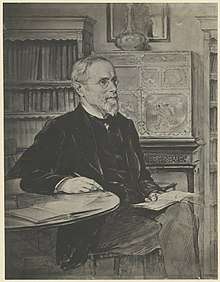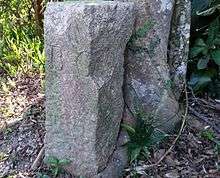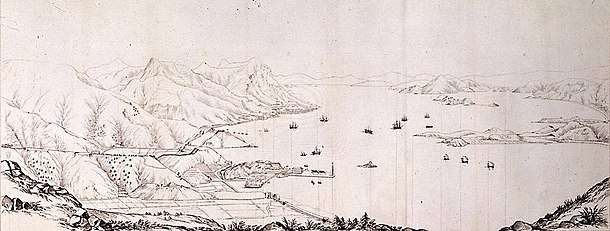Thomas Bernard Collinson
Major General Thomas Bernard Collinson (18 November 1821 – 1 May 1902) was an English military engineer of the Corps of Royal Engineers who carried out the earliest British surveys of Hong Kong, and planned roads and other early military and civil engineering works in New Zealand. Immediately prior to retirement, he was architect to the Scottish Prison Commission.

Origin and military service
Collinson was born in Gateshead, County Durham, ninth child of Rev. John Collinson, Rector of Gateshead, and Amelia King.[1] Educated at the Royal Military Academy, Woolwich, he was commissioned in the Corps of Royal Engineers as No. 683, with the rank of second lieutenant, on 16 June 1838, spending his first five years on Ordnance Survey work in Wales, Ireland and Northern England. He advanced to rank of first lieutenant on 9 March 1841 and was sent to Hong Kong and New Zealand in 1843. His service over the years before his retirement with the rank of major-general, in 1873, took him to Hong Kong, Sydney, Auckland, Wellington, Wanganui, Hobart Town, London, Waltham Abbey, Aldershot, Corfu, Malta, Chatham and Dover.[2] He was the younger brother of Sir Richard Collinson, RN, who pioneered coastal surveys of southern China, and commanded HMS Enterprise in the 1850–1855 search for Sir John Franklin's expedition missing in the Northwest Passage since 1845.
Surveying Hong Kong

Given the task of mapping Hong Kong, from 1843 to 1845, Collinson established 27 trigonometric stations around Hong Kong Island in order to produce the first set of scientifically surveyed maps of Hong Kong, the Ordnance Map of Hong Kong published by the Board of Ordnance in 1845. Collinson used the French contour mapping method of which he was an early proponent. Only one stone station marker now remains, revealed by a University of Hong Kong team on 3 October 2015, at Lei Yue Mun Park.[3][4]

Collinson made the first records of many place names, including prominent locations in today's Hong Kong: Shek O, Chai Wan, Shau Kei Wan, Quarry Bay, Tai Tam, Tin Wan, Wan Chai, and Pok Fu Lam. Cape Collinson, Mount Collinson, Collinson Street, Cape Collinson Road and Path, on Hong Kong Island, were all named in his honour.[6] Collinson was rewarded by the engraving of his map at Ordnance Survey, Southampton, and with a compliment from the geographer John Arrowsmith that it was the most complete map he had ever seen. He also produced early detailed sketches of Hong Kong.[7]:25 His drawings were of such an admirable standard that Major Edward Aldrich, RE, illustrated his 21 July 1846 report on the erection of Ordnance buildings in Hong Kong with them.[8]
New Zealand
On 11 June 1846, Collinson embarked on the Emily Jane for Sydney, New South Wales, and after a brief stay there, he sailed for Auckland, New Zealand, on the trading brigantine Terror, arriving on 19 September 1846 to difficult times of conflict between the Pakeha settlers and the native Māori population. By November, he had sailed for Wellington and then spent over three years working on military buildings and defences there and in Wanganui.[9] Collinson was a keen illustrator and many examples, some featuring Māori, are kept at the Alexander Turnbull Library of the National Library of New Zealand.[10]
Collinson returned to his station in Wellington in 1848, where duties included a plan for the defence of Wellington, the arrangement and construction of military buildings, and a report on the earthquake that damaged the Paremata Barracks at Porirua. He also made occasional visits to Wanganui and explorations about the local countryside.
Sometime about September 1849 Lieutenant-Colonel Daniel Bolton, RE, sent Collinson a note saying that Lieutenant James Liddell, RE, was on his way to New Zealand with some sappers and that Collinson was ordered home. Collinson wrote to his sister Charlotte saying he’d hoped to be left to finish plans for his grand fortress—Mt Cook Barracks, Wellington. The great undertaking to produce an Ordnance map of New Zealand would have to be left to some future Commanding Royal Engineer.[11] Liddell, age 20 years, had left England on the brig Richard Dart on 5 April but, by the time of Bolton’s note, had perished with a good part of his detachment of twenty-eight Royal Sappers and Miners when the ship struck rocks at Prince Edward Island of the Prince Edward Islands, sub-antarctic Indian Ocean, on 19 June 1849. In consequence, Lieutenant Francis Rawdon Chesney, RE, set out for New Zealand in March 1850 with a detachment of twenty-seven Royal Sappers and Miners.[12]
Collinson completed a paper on New Zealand timber trees, with notes supplied by the naturalist William John Swainson, FRS, in February 1850 and in the following month, March, departed New Zealand for Hobart Town, Van Diemen’s Land (Tasmania), on a homeward bound journey to England. During his service in New Zealand, he had served under two Commanding Royal Engineers—Brevet-Major William Biddlecomb Marlow, RE, and Lieutenant-Colonel Daniel Bolton, RE.
Homeward Bound
Whilst at Hobart Town, Van Dieman’s Land, on Tuesday, 26 March 1850, Collinson forwarded his paper 'On Timber Trees of New Zealand' to the Royal Society of Van Dieman’s Land along with samples of timber and dried leaves of the principal forest trees found in the southern part of New Zealand, and was admitted into the Society at its April meeting. His paper was read before the Society on 10 July 1850 and published in the following year.[13]
England
On his return to England in 1850, he was soon employed at the Great Exhibition as the ‘Superintendent of British Side of Building' under the general superintendence of Colonel Sir William Reid, RE. He also supplied the statistics of New Zealand for publication in the Official Descriptive and Illustrated Catalogue. For the New Zealand exhibit, South Area Q and R 32, his father, the Rev. John Collinson, provided article no. 3.—geological specimens, iron sand from New Plymouth, a small bag made of New Zealand flax made by a lady, flax prepared by Māori (native pattern and dyes) and a mat of New Zealand flax made by Māori.[14] Following this he was sent to Waltham until placed in command of the Royal Engineers at Aldershot in 1856. That year he married Katherine Baker, daughter of the Rev. J Baker, Chancellor of the Diocese of Durham,[2] and Catherine Haggit.
Death
Collinson died at Little Haven, Ealing, on 1 May 1902. He was a wealthy man, leaving an estate of £20,534 10s 8d.[9]
Publications
- Collinson, Thomas Bernard (1850). "30. The Commanding Royal Engineer, New Zealand, to the Inspector General of Fortifications, forwarding a Copy of a Report from Captain Collinson, Royal Engineers, on the several Military Posts in the Southern District, dated 16th April, 1848, with a Plan; Report on the Port Nicholson District". Corps Papers, Memoirs on Military Subjects; Compiled from Contributions of the Officers the Royal Engineers and the East India Company's Engineers. London: John Weale. 1: 389–396.
- Collinson, Thomas Bernard (January 1851). "On Timber Trees of New Zealand". Papers and Proceedings of the Royal Society of van Dieman's Land. Tasmania: Royal Society of Tasmania. 1 (3): 225–234.
- Collinson, Thomas Bernard (28 September 1850), Memorandum Concerning the Military Defence of Honolulu, San Francisco
- Collinson, Thomas Bernard (1853). "2. Remarks on the Military Operations in New Zealand" (PDF). Papers on Subjects Connected with the Duties of the Corp of Royal Engineers. London: John Weale. New Series 3: 5–69.
- Collinson, Thomas Bernard (1855). "2. Continuation of the Remarks on the Military Operations in New Zealand" (PDF). Papers on Subjects Connected with the Duties of the Corp of Royal Engineers. London: John Weale. New Series 4: 22–50.
- Collinson, Thomas Bernard (1855). "3. Breaching Stockades with Bags of Gunpowder at Chatham: Accompanied by the Records of Experiments made at the Royal Engineer Establishment at Chatham, in 1846-47" (PDF). Papers on Subjects Connected with the Duties of the Corp of Royal Engineers. London: John Weale. New Series 4: 51–53.
- Collinson, Thomas Bernard; Hale, Lonsdale H. (1858). "12. Temporary Artillery, Cavalry, and Royal Engineers equipment stabling erected at Aldershot in 1856; Memoranda on providing temporary accommodation for twelve hundred cavalry horses, in the north camp at Aldershot, agreeably to the order of the Inspector General of Fortifications" (PDF). Papers on Subjects Connected with the Duties of the Corp of Royal Engineers. Woolwich. New Series 7: 88–98.
- Collinson, Thomas Bernard (1862). "6. Description of the Ruins of the Acropolis of Cassope, in Epirus, 15 Miles North of Prevesa. 1860". The Journal of the Royal Geographical Society of London. 32 (3): 68–74. doi:10.2307/1798400. JSTOR 1798400.
- Collinson, Thomas Bernard (1861–62). "1. Description of the Ruins of Cassope". Proceedings of the Royal Geographical Society of London. 6 (3): 106–107. doi:10.2307/1799096. JSTOR 1799096.
- Collinson, Thomas Bernard (1865). "Iron Casemates—Part II: Projects for Iron Casemates" (PDF). Papers on Subjects Connected with the Duties of the Corp of Royal Engineers. New Series 14: 83–126.
- Collinson, Thomas Bernard (1865). "Iron Casemates—Part I: On the Application of Iron to Casemates" (PDF). Papers on Subjects Connected with the Duties of the Corp of Royal Engineers. New Series 14: 69–83.
- Collinson, Thomas Bernard (1869). "A Proposition for One General Military School for the Army". Journal of the Royal United Service Institution. 13 (54): 241–262. doi:10.1080/03071846909424323.
- Collinson, Thomas Bernard (1874). "The Strategic Importance of the Military Harbours in the British Channel as Connected with Defensive and Offensive Operations". Journal of the Royal United Service Institution. 18 (77): 227–264. doi:10.1080/03071847409427634.
- Collinson, Thomas Bernard (1876). "A Warning Voice from the Spanish Armada". Journal of the Royal United Service Institution. 19 (81): 285–333. doi:10.1080/03071847509415970.
- Collinson, Thomas Bernard (1876). "Another Warning Voice from 1805". Journal of the Royal United Service Institution. 20 (85): 1–60. doi:10.1080/03071847609427099.
- Collinson, Thomas Bernard (1877). "On the Present Facilities for the Invasion of England, and for the Defence Thereof". Journal of the Royal United Service Institution. 21 (89): 1–37, 38–39. doi:10.1080/03071847709417092.
- Collinson, Thomas Bernard (February 1877). "Mobilisations and its aftermath". The Royal Engineer Journal.
- Collinson, Thomas Bernard; Collinson, Richard (1877). "On the Use of the "Torpedo" and the "Ram" in Resisting Invasion: Or the "Battle of the Boats"; Addressed to the People of England, the Dearest Interests of Everyone of Whom Are Involved in the Result". London: W. Mitchell. Cite journal requires
|journal=(help)
- Collinson, Richard (1889). Collinson, Thomas Bernard (ed.). Journal of H.M.S. Enterprise, on the Expedition in Search of Sir John Franklin's Ships by Behring Strait. 1850-55. London: Sampson Low, Marston, Searle, & Rivington.
- Collinson, Thomas Bernard (March 1890). "Col. Sir H. Yule, R.E., C.B., K.C.S.I.". The Royal Engineer Journal.
- Collinson, Thomas Bernard, Seven Years Service on the Borders of the Pacific Ocean, 1843–1850. Written for the Information and Satisfaction of my Children, 2, unpublished (Alexander Turnbull Library, MSZ-1433)
- Collinson, Thomas Bernard, Seven Years Service on the Borders of the Pacific Ocean, 1843–1850. Written for the Information and Satisfaction of my Children, 1, unpublished (Alexander Turnbull Library)
- Collinson, Thomas Bernard (1903). Webber, Charles Edmund (ed.). General Sir Henry Drury Harness, K.C.B.: Colonel Commandant Royal Engineers. London: Royal Engineers Institute Committee.
Maps
- Collinson, Thomas Bernard (1845). The Ordnance Map of Hong Kong. Surveyed by Lieutenant Collinson, R.E., 1845 (Map). 4 inches to 1 mile. Southampton: Ordnance. (Select 'Map 1845')
- Collinson, Thomas Bernard (1846). Hong Kong Harbour from a hill above Chauseway Bay, 500 feet high (Map).
References
- Davies, Stephen (2012). Dictionary of Hong Kong Biography. Hong Kong University Press. p. 107.
- Proceedings of the Institution of Civil Engineers, Vol 150. Institution of Civil Engineers. 1902. doi:10.1680/imotp.1902.18336.
- Nip, Amy (16 December 2015). "HKU students discover old boundary stone in park". The Standard. Retrieved 17 December 2015.
- Cheng, Kris (17 December 2015). "HKU urges heritage status for oldest boundary stone ever discovered in Hong Kong". Hong Kong Free Press. Retrieved 17 December 2015.
- Collinson, Thomas Bernard (1846). Hong Kong Harbour from a hill above Chauseway Bay, 500 feet high (Map). Retrieved 2 April 2020.
- Yanne, Andrew; Heller, Gillis (2009). Signs of a Colonial Era. Hong Kong University Press. ISBN 978-9622099449.
- Nicholson, Ken (2010). The Happy Valley. The Hong Kong University Press. ISBN 978-9888028108.
- Aldrich, Edward (1849). "Description of the Mat Covering Sheds used at Hong-Kong in the erection of the Ordnance Buildings, and of the mode adopted by the Chinese in transporting and raising heavy Weights for these Buildings" (PDF). Papers on Subjects Connected with the Duties of the Corps of Royal Engineers. 10 (6): 153–155.
- Heath, Philip. "Thomas Bernard Collinson". Retrieved 18 December 2015.
- "Thomas Bernard Collinson". National Library of New Zealand. Retrieved 18 December 2015.
- Letter from Thomas Bernard Collinson, Wellington, New Zealand, to Charlotte Collinson, Gateshead, England, 23 September 1849
- "Wreck of the Brig 'Richard Dart'". New Zealand Spectator and Cook's Strait Guardian. 6 (481). 13 March 1850.
- Collinson, Thomas Bernard (January 1851). "On Timber Trees of New Zealand". Papers and Proceedings of the Royal Society of van Dieman's Land. 1: 225–234.
- (1851) "New Zealand", Official Descriptive and Illustrated Catalogue of the Great Exhibition of the Works of Industry of All Nations, Part 4—Colonies and Foreign Countries. By Authority of the Royal Commission. Spicer Brothers, London. 1851. p. 1000.